Friday 1 December 1989 Ottawa to Guatemala City
Joe Toscas
and I flew to Guatemala City today via Dorval and Miami where we were
met by Louise, Virginia and Fernando for a quick (Joe's family).
We arrived at Guatemala City after dark and were met by Fernando,
the local guide. Couldnčt see very much of the city althou we were told
that things were quite calm and safe there.
Saturday 2 December 1989 Guatemala City to Coatapeque
Up
bright and early today. Met the rest of the group at a sparse
continental breakfast and then into a coach for a short ride to the
station where our three special cars (private car, restaurant car and
coach) were attached to the back of the passenger train. Or they
should have been. After some argument with the stationmaster the
coach was cut in as well. We had a chance to look around the
roundhouse and shop tracks. This area was shared by red Babcock
and Wilcox diesels built in Spain and large blue Bombardier units.
The Bombardiers look to be big brutes for the narrow gauge.
The star of the shop area was Baldwin 2-8-2 #205 which has
been repainted and would be working two steam specials for us a few
days later. Another 2-8-2, #200, was also receiving a paint job.
We
left late on the passenger train which is, in fact, a mixed train, and
we managed to progressively lose time throughout the day. The
average speed, taking into account the maximum of 15 mph, and the en
route switching, was 10 mph. The outskirts of Guatemala City are
pretty torrid. I have never seen such squalid housing and so many
children, The most memorable was a hut built of cardboard.
People actually live in there.
Things were better once we
were in the country. There were great views of volcanoes, three
of them active. We crossed Lake Amatitlan at a point where it narrows
and then there was evidence of volcanic activity in the form of hot
sulphurous springs. There were lots of flowers - bourgainvillas,
frangipani, African tulip trees and hibiscus. Many bananas,
papaya and mango trees. As we began to drop down the steep grades
into the coastal lowlands the sugar cane became much in evidence along
with coffee and its accompanying shade trees. One of the party,
Marty, is a birdwatcher and was able to identify the many species of
tropical birds we saw. One of the first were the turkey vultures,
big black birds that circled ominously over the train.
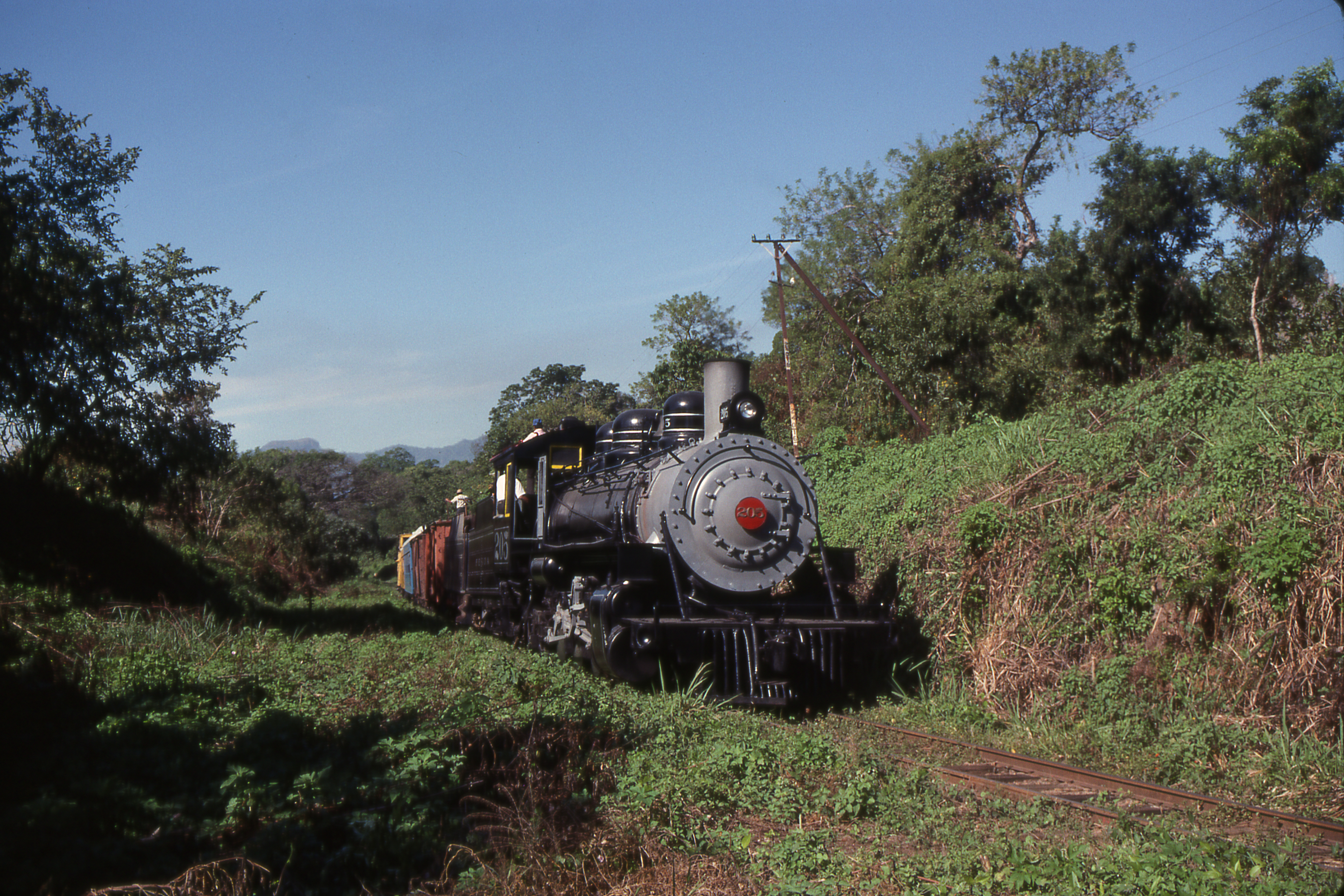 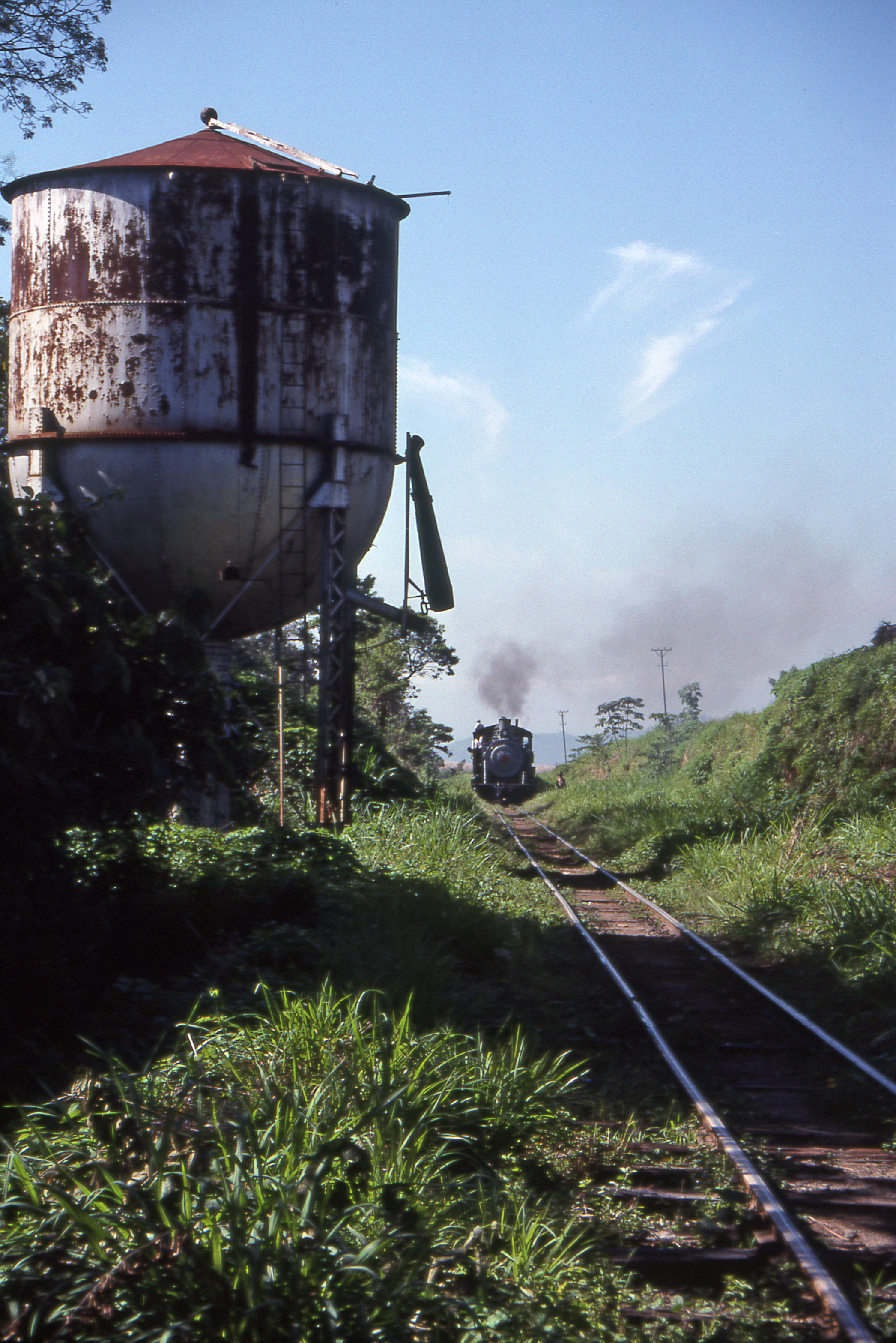
There
was much switching at Escuintla where there was a GE 60T #704 in the
roundhouse, Lunch was a substantial box affair with fried
chicken. There were some coolers on board with beer and soft drinks
available on the honour system.
We struggled on through Santa
Maria amid cane fields and the afternoon was a little boring. In
the country people live in bamboo huts with mud floors. They seem
to be well fed and clothed. Many of the huts had televisions. Everyone
came out to watch the train and there were many children at each
doorway. The late afternoon was livened up by a tropical downpour.
It
was dusk by the time we arrived at Matzatenango. There was much
switching to be done while the train crew pounded the tar out of
several trucks to reset the springs. After the switching the
locomotive, #900, was taken over to the shop where the crew "serviced"
it. All this time the passengers waited quietly in the train
buying food, drinks and ice cream from hawkers on the platform. A
great flock of turkey vultures glided silently over the little town
into the sunset.
This crew worked all the way through from
Guatemala City to the Mexican border, They were on duty for 19
hours, had five hours rest and then came back the next day.
We
eventually arrived at Retalhuleu in the dark and were met by the bus
which had followed us. It had been a hard 126 miles. The
bus took us to Coatapeque to an excellent hotel called Virginia.
We had dinner and tumbled into bed - exhausted.
Sunday 3 December 1989 Coatapeque to Escuintla
We
were woken up early by the parrots and lorikeets. After an
electrifying (literally) encounter with the shower we had a quick
breakfast and explored the beautiful grounds with views of the
volcanoes and with many flowers and big trees. The ride back to
Retalhuleu was interrupted for a quick visit to coffee and rubber
plantations where there was a large woodpecker and many hawks.
The
train was two hours late at Retalhuleu and so there was time to have a
quick look around the town on a bustling Sunday morning. Many
were wearing traditional costume. There was a man in a skirt
wearing a brightly decorated hat. Joe and I bought some rum at a
bar and talked with the locals. Everyone was very frindly when
they found out that Joe spoke Spanish and when they saw the Canada flag
on my jacket.
The train arrived in a cloud of dust from the
earth ballast - there being no such thing as rock ballast. Joe
and I rode the locomotive as far as Mazatenango. (this was presumably a diesel) It was
interesting and a little worrying. The rails are kept in place by
the grass. We nearly hit a car at a crossing in spite of the low
speed. The engineer was a happy go lucky person. He didn't
know whether the track was safe but he just ran his locomotive at a
maximum of 15 mph. The speedometer and deadman's pedal had been cut
out. Everywhere we disturbed great clouds of butterflies which flew up
on our approach.
On and on we rode relentlessly through
yesterday's cane fields with occasional superb views of an active
volcano. We detrained at Santa Maria which was the junction with the
branch to the port of San Jose. The bus was waiting and we went to the
port through another tropical downpour. There was not much to see
at the port although an active Plymouth and several derelict hulks at
the Granelsa terminal made the trip worthwhile.
It was dark by
the time that we arrived at the hotel in Escuiltla. Had a good
supper at the hotel dining room after struggling with the lock on the
door. Again early to bed.
Monday 4 December 1989 Escuintla to Guatemala City
Up
in good time for a good breakfast at the hotel. The sun was
shining in a clear blue sky with good views of an active volcano with
its plume of smoke. We were amused to watch the gas station
across the road. With every fill up a team would throw water over
the vehicle. You can always tell the whereabouts of a gas station
by the stream of water across the road.
The bus took us down to
the station at Escuintla and we were let loose to find steam locomotive
#205 and watch it on the turntable. The sun was just right to get
shots of the engine on the turntable with palm trees and a
volcano in the background. GE 60 tonner #704 moved some boxcars out of
the way so that we had a great view of a simulated arrival and take off
at the station. Joe and I rode the engine as far as the first run
past. It rode quite well and seemed in pretty good shape The crew made
a practise of overfiring so that there was a continuous drumming from
the fire which was deafening. We were on pretty steepp grades (up to
5%) and so I presume this was the reason for this. Chris Skow, the tour leader, mentioned
that the undergrowth grows so quickly that a good spot one year might
be useless the next. I think my favorite was the second one which
was at a water tank. A man was walking along the track. He
conveniently stepped to one side for the train and then resumed his
plodding after it had passed. Great for video but the still
photographers didn't seem too pleased. In many cases it was possible to
use groups of children as an interesting counter to the train.
I
rode the roof for part of the tough climb into the Sierra Madre
mountains. At the summit the land is much drier although there are
still many tropical plants such as bourgainvilla and poncietta. There
were a couple of good run pasts at Lake Amatitlan and then a horseshoe
curve. The approach to Guatemala City is marked by the slums which must
be as bad as any in the world.
Arrival back in Guatemala City
gave us some time to wander around the market which is close to the
hotel. We had a great time changing money. The banks will not
accept Canadian dollars. Good job I was travelling with US dollar
travellers cheques.
There is an Indian market for the tourist
against the walls of a square and along a narrow street. These
are covered in colorful items with indian designs but really producing
little of interest. The produce market was very interesting with
its great selection of different peppers. There were small sections
devoted to pottery and wood carving. Many Christmas decorations which
seems strangely out of place in a land which does not know snow. In the
main square they are building a large Christmas tree - a gift from the
President's wife.
Tuesday 5 December 1989 Guatemala City to Puerto Barrios
Up
early and back to the railway station to catch the train towards the
Atlantic coast this morning. Our three cars were attached to the
rear of the train which was marshalled backwards in the single ended
station. #701 coupled on to the rear and hauled us out into the
yard where we were attached to freight cars and the train locomotive
which was #912. We then headed east through a better part of town - at
least it didn't have the really poor shacks. There is a
spectacularly long, high bridge over a ravine on the outskirts of the
city. The morning was spent on the back platform looking for good
places for run pasts as we will take this route on our steam special in
a couple of day's time.
The countryside was much drier in this
area. Again, there are some signs of volcanic activity with hot
springs. One village was named Agua Caliente. Many butterflies
including some irridescent black and green ones with a red spot on the
wings. Spent some time at Cucajol waiting for a meet with big blue
Bombardier #1002 "El Progresso". All the townsfolk came out to
stare at us.
We saw a long line of trucks waiting for a load at
a cement plant. Must have been at least seven miles long. It is
incredible that the transport system should be so screwed up.
The
country became progressively drier and tobacco and ranching were
the main activities. Lots of tall cactus and many vultures
overhead. Maybe they know to follow the train.
We arrived
at Zacapa just before 15:00 and all bar two of our number detrained.
There was just enough time to have a quick look at the roundhouse
with its three derelict steam locomotives and an additional two on a
storage track. Must have been a very busy place at one time. This is
the junction for the line to El Salvador but it is not seeing any use
at present because of the civil war in El Salvador.
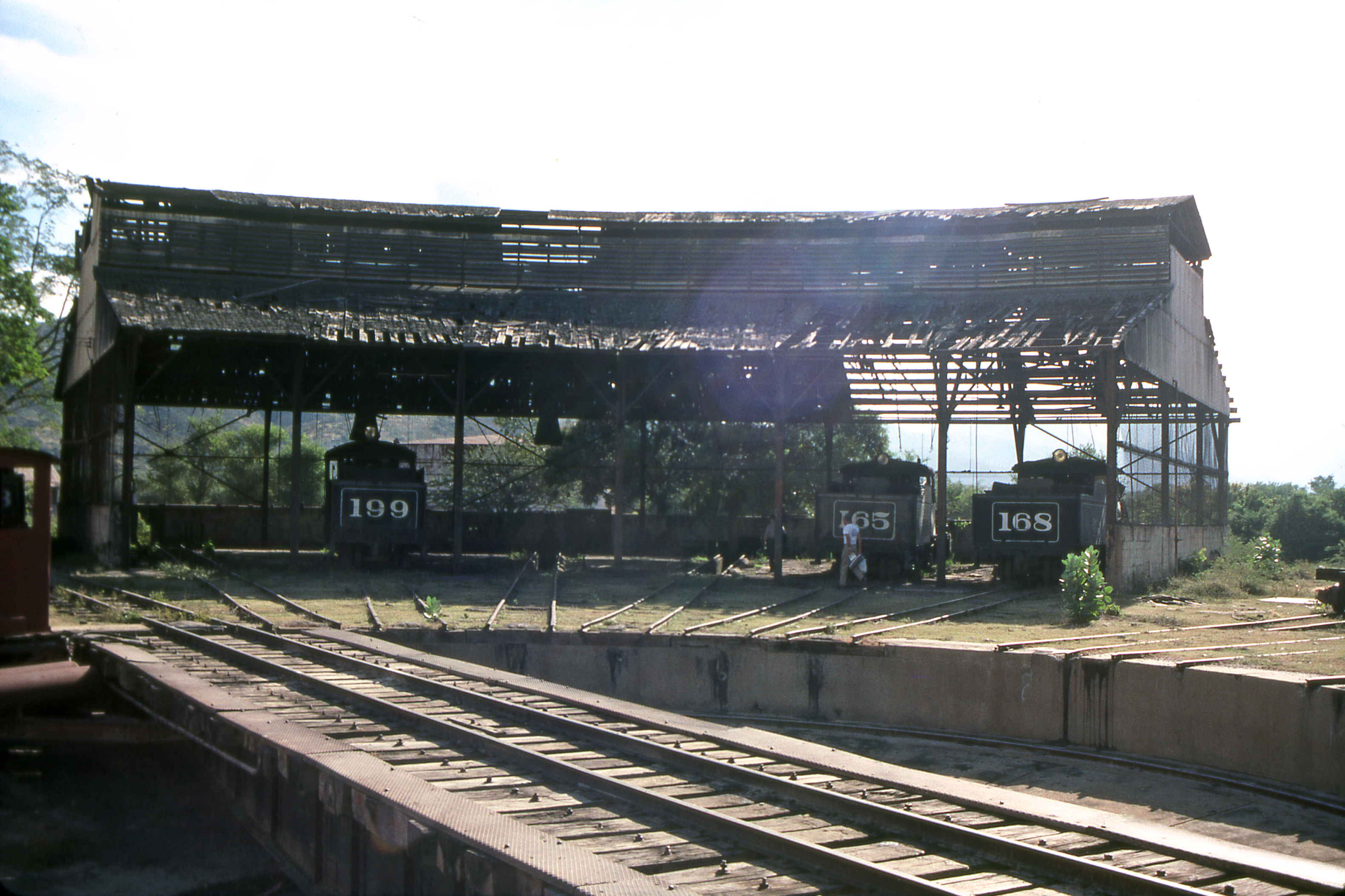 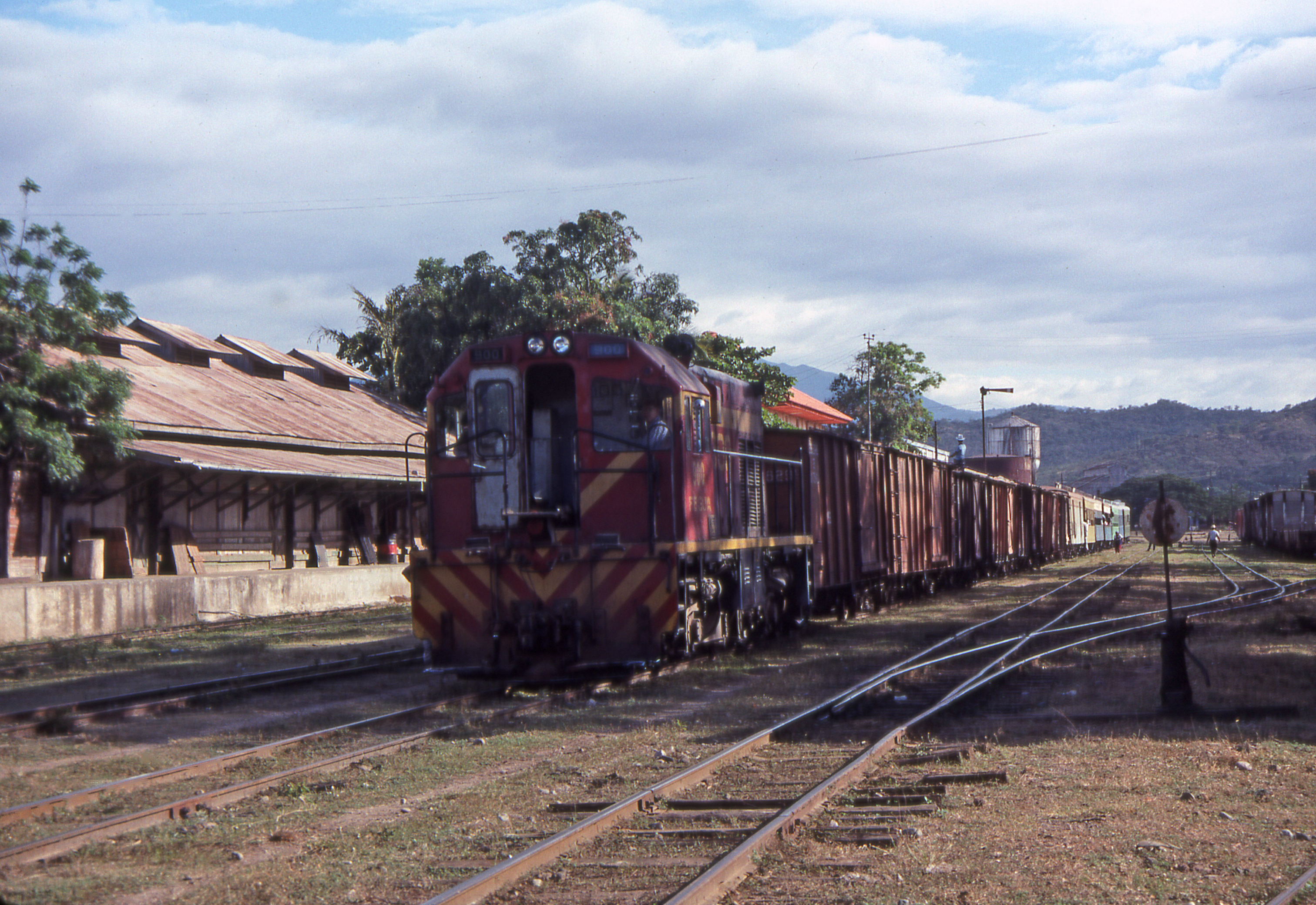
Zacapa
From
Zacapa to Puerto Barrios we travelled by bus which had followed us down
from Guatemala City. It was only 100 miles but this took four
hours because of the deplorable state of the roads. It is
literally being torn apart by heavy trucks.
We passed a
westbound train just east of the turn off to Querigua. It must
have derailed immediately after we had passed. Our eastbound
train was annulled 48 miles out and the two from our party that
travelled on it finally made it in by pick-up truck around midnight.
Nobody knows what happened to the hapless locals that found themselves
stranded out there.
As we moved east the country became wetter
and banana plantations took over, the last half of the journey was
undertaken in darkness and was pretty boring.
The hotel at
Puerto Barrios was pretty spartan. It was an old colonial hotel
complete with creaky floorbooards and superannuated waiters. The
malarial bathroom with its one tap made me want to dress up for
protection rather than strip down to get clean. I decided to wear
my flip flops into the shower. The food in the dining room was
not of the best although we probably made a mistake ordering lobster
which was very dry. I enjoyed the frijoles. We decided not
to sample the nightlife and got to bed early.
Wednesday 8 December 1989 Puerto Barrios to Rio Hondo
Woke
up to find that the hotel has a view over the bay which is the
Caribbean Sea. It looked pretty polluted and was made worse by a
mist that turned into a tropical deluge.
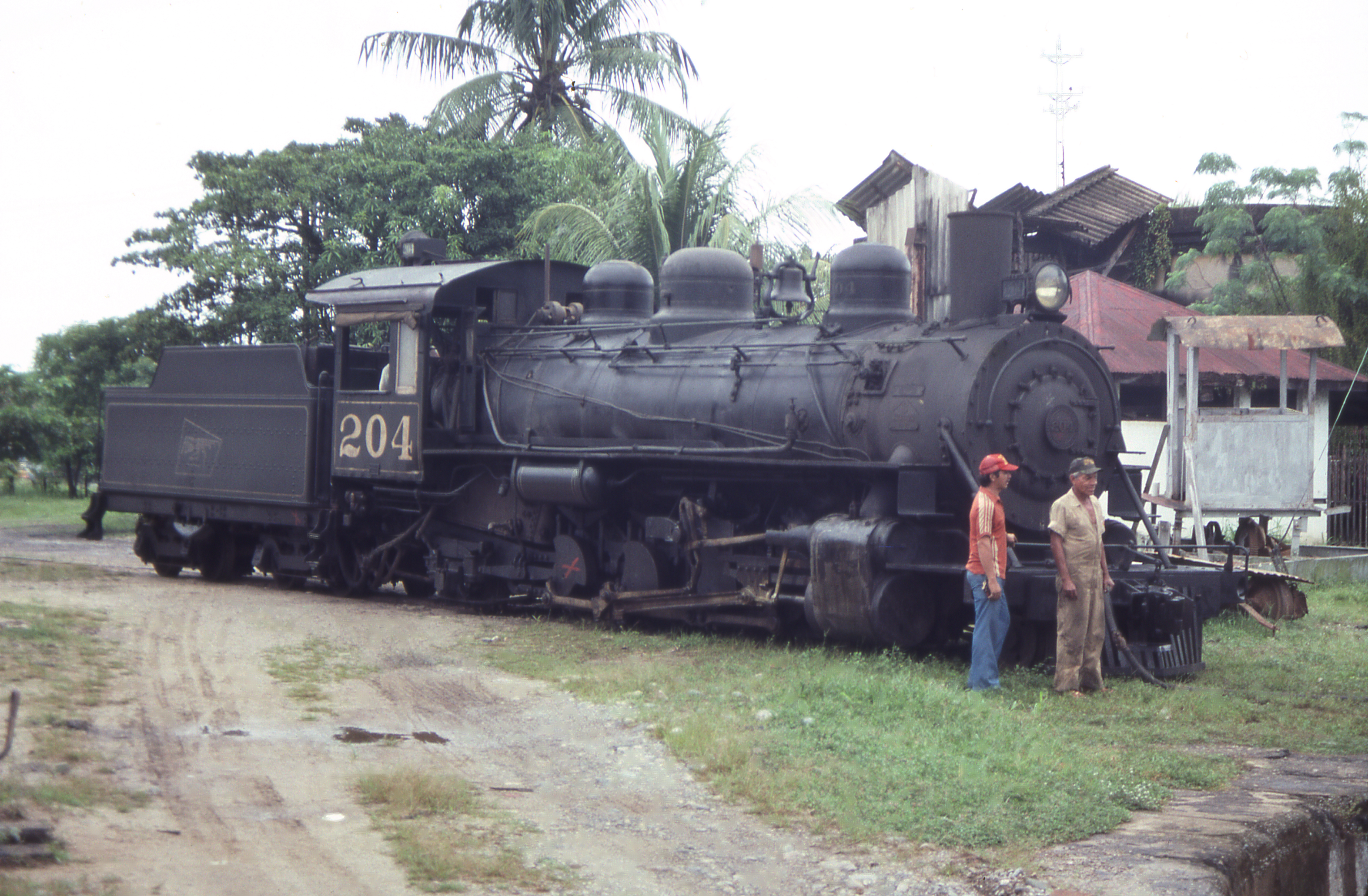 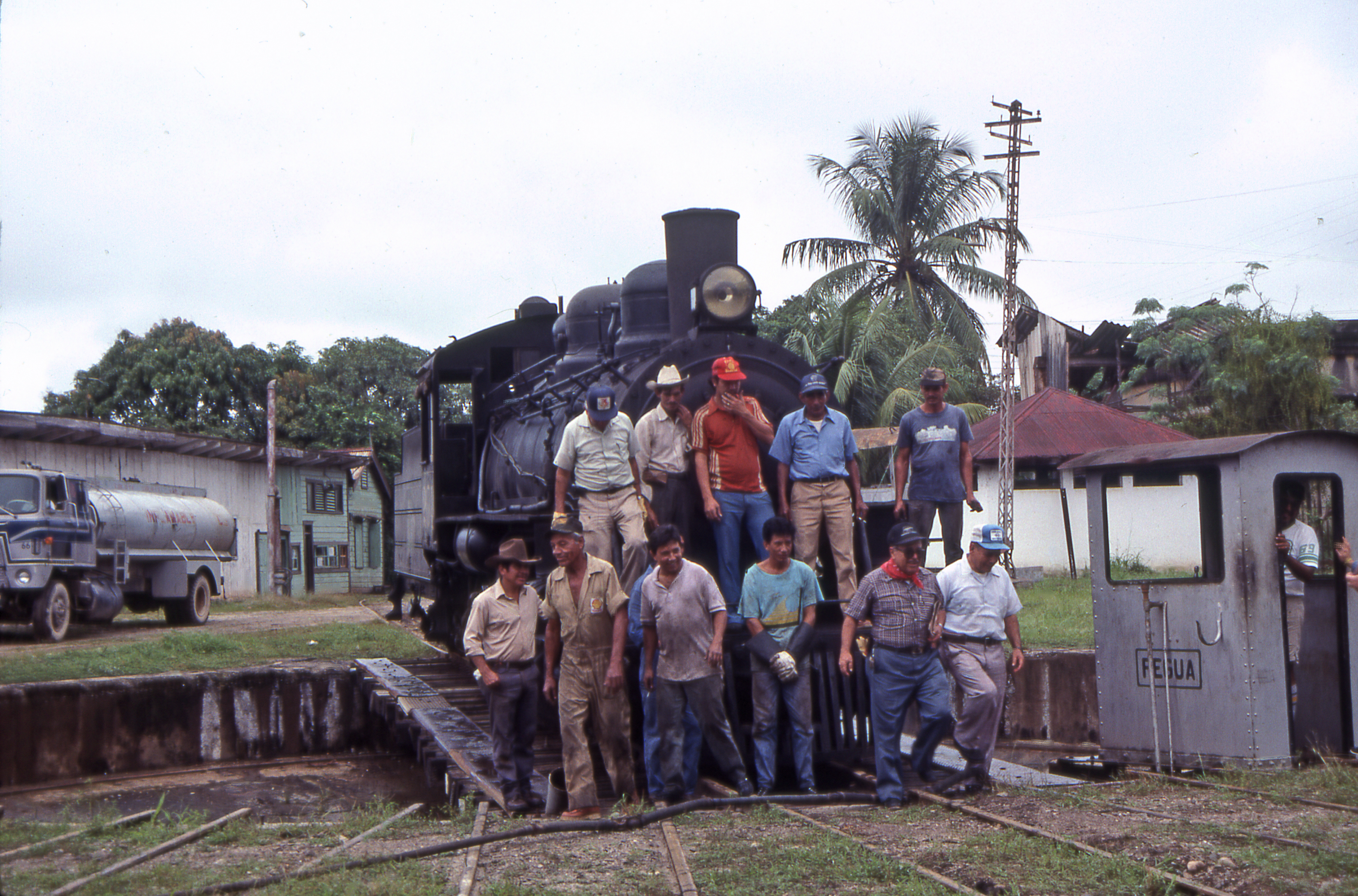 Puerto Barrios
Puerto Barrios
The yard office at
Puerto Barrios was a tin shack. There was an awning in front from
which it was good to stand and film without getting wet. There were
several hands of bananas lying on the floor and a woman came in with a
basket of fruit on her head. She proceeded to peel the fruit and was
ready for business. The railway dog was out to supervise the
proceedings as steam locomotive #204 made up a freight train for us.
The damp weather produced some good steam effects for us and there was
much excitement among the locals.
Our small train was made up
with some hindrance from #803 which was also switching the yard and we
eventually backed down to the jetty which runs right out into the sea.
On a good day this would have been a great shot but the rain
spoiled things,
From there we proceeded back through the yard
and out of town to the end of yard limits. The rain had eased up and it
was possible to get some good shots. At least the shadows were not
a problem. We stopped by a bridge where the drill was to go through a
woman's house so we could get a good view of the runpast over the muddy
water. Chris Skow does this every year. The lady is happy because he
pays her for the privilege. The house has a mud floor and wooden walls.
It was very dark inside but I could see many religious paintings.
The
local people make a sort of trolley with bearing races that fit the
gauge of the track and use this to get into and out of town. There
seems to be two models. A low type is used mainly for freight.
There is also a higher type which is rather like a bench so that
people can sit in comfort. These are pushed by small kids or
poled along by one of the people sitting on the bench. They are
sturdily built and will take seven small people. These see a great deal
of use and there is much arguing as to who should take off to allow an
opposing movement. It seems that loads take precedence over
empties or passenger movements. They wait until the last moment to get
out of the way of trains.
This
was pretty thick jungle. People were living in bamboo huts in
pretty swampy conditions. I checked that I had taken my malaria pills
as this disease must surely be a problem in this area.
After a
morning of run pasts the engine was taken back to the roundhouse where
the plan was to spin it on the tuentable a couple of times and then put
it in stall 2. #204 couldn't pump enough air to work the table.
The first time it managed to move about 60 degrees to line it up
for the engine to run on. Twenty or so supervisors conferred
(read - shouted) among themselves and decided to use #803 as a source
of air. #803 was duly summoned and came in through the back way.
It pumped up the air and was then backed up out of the way so we
could get our shots. This had to be done twice and in the end there was
only enough air to get round as far as stall 5 so they decided to put
the engine in there. Stall 2 was unoccupied but stall 5 had some track
cars in it so we were unable to see the engine go right into the
roundhouse. Amazing what they will do to make us happy.
Joe and
I walked back to the hotel and bought a bottle of 23 year old rum from
Zacapa. Lunch was served by the same waiter who must have been at
the hotel for a long time. We then boarded the bus for a slow
journey back over the same road we traversed yesterday. We passed
the train wreck and then made a detour to see the Mayan ruins at
Querigua. This is in virgin jungle. Very hot and very, very
steamy. The rest of the area is vast banana plantation complete with
its own monorail system for bringing the bananas into the central
processing area. We caught a quick glimpse of a banana monorail
train. Quite amazing to see what the Maya constructed and a good
tesaser for Tikal which we will be visiting at the end of the week.
Our
arrival at the hotel was after dark. Looks to be a good place
with an enormous pool. Dinner was a lot of fun. Joe acted as
interpreter for the waitress and as a reward we were given an extra
plate of shrimps as well as ice cream with the fruit salad for dessert.
Not quite sure where the hotel was located. Somewhere around Rio Hondo,
I believe.
Thursday 7 December 1989 Rio Hondo to Guatemala City
The
hotel was indeed a pleasant place as we found out next morning. There
were a number of domesticated parrots in a tree in the grounds.
After
breakfast we bundled into the bus, which had been repaired overnight,
and made for El Rancho. This was not as easy as it had originally
seemed because the bus was too wide for a narrow bridge on the main
access road to the town. We tried another track which turned into
a stream but made it on the third try. We entered town down a
narrow back street. It is a pretty safe bet that very few
tourists, if any come here. The entire town turned out to gawk at
the gringos.
The train arrived just after we did. Steam engine
#205 lead a motley collection of cars, this time with a wooden caboose
bringing up the rear. The whole assembly rocked and rolled its way into
town, recorded by the few who were observed by the townsfolk.
Upon arrival one of the passenger cars had to be switched out
because the load would have been too great and a boxcar was switched in
between the second tender and the passenger cars. It was like a
festival day as the engine took water before our departure.
The
trip back to Guatemala City took the whole day. There are a
number of impressive trestles, many of them curved, and there were
plenty of photo opportunities. The vultures continued to circle
overhead. The closer we came to Guatemala City the more people came out
to see us. The train would stop in the middle of nowhere for a
run past and a group of locals would appear and take an interest in the
proceedings.
The wooden caboose provided an extremely
interesting ride. The trucks moved differently from the frame
which moved differently from the body which moved independently from
the cupola. It moved in a series of jerking motions as the body
caught up with the fairly constant pull through the drawbar.
We
had a meet with a mixed train at Jalapa. The station sign said
this but according to the map, the village of this name is about 15
miles to the south. The other train was hauled by a blue Bombardier,
#1000 "Zacapa". This would normally have been a job for a 900
series locomotive but these were likely all tied up by the derailment
near Querigua.
The
last run past was probably the most spectacular of the trip. It
was at the enormous bridge over the ravine on the outskirts of
Guatemala City. There is a severe speed restriction and we all
enjoyed the sight of the steam engine taking its time to traverse
the amazing structure.
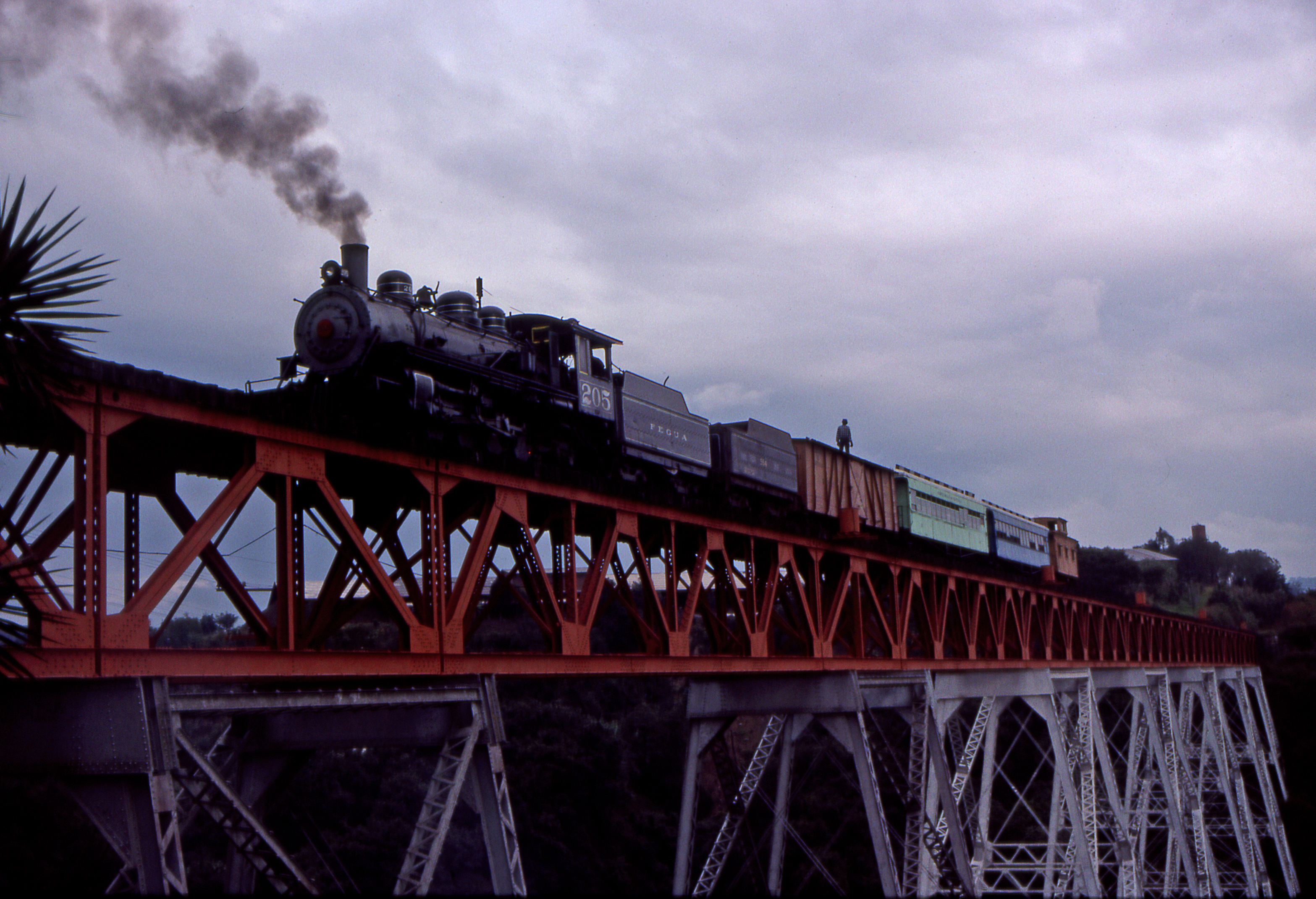 
The trip to the station runs right
through a brothel. The girls were all lined up in the doorways of
their huts. They were all dressed up, some in outlandish clothes, some
in see-through clothes. They were standing not ten feet from the
train.
Back to the Pan American hotel for the rest of the stay. Not the greatest but relatively comfortable.
Thursday 7 December 1989 Guatemala City - visit to Antigua
Today
we went by bus to Antigua which was the former capital of Guatemala
until destroyed by an earthquake in 1733. Before this e were
taken to see a concrete relief model of Guatemala. This was very
impressive and it is a pity the rivers do not flow any more because of
earthquake damage. There was a park nearby and poor children were being
brought in to see Father Christmas and some clowns.
They have
made a great deal of the ruins of Antigua but they are not very
interesting. I found a restored house much more interesting. This
was still being lived in but had been restored to its original form and
was open to the public at limited times.
We had some time at the
town square. Joe and I walked down to the market which was
beginning to close up and had lost the hustle and bustle which would
have been normal earlier in the day. There was a circus in town and an
elephant was being paraded through the streets dressed up like Santa
Claus. Some cute little kids were trying to sell us things. They
couldn't have been more than three but they had been taught to pick
pockets.
Back at Guatemala City Joe and I went out for a stroll
along one of the crowded city streets. It was very interesting.
People were selling virtually everything. We felt quite
safe and didn't notice any attempt to jostle us or go for our pockets.
Most of the crowd are shorter than we are.
Friday 8 December 1989 Guatemala City - visit to Tikal
This
morning was a dress rehersal for tomorrow at the airport. We were
taken out in good time only to have to wait for over an hour for the
plane to leave for Tikal. The cloud was low at our destination
and we couldn't take off until it was safe to land. The DC9 was painted
up for AEROQUETZAL but it turned out to be a KLM plane on lease.
We landed at the military airfield at Santa Elena which is close
to Flores on Lake Peten Ixa. Flores looks to be an interesting place.
It is built on an island in the lake and is connected to the
mainland by a causeway.
The bus to Tikal was uncomfortable
because of the exhaust fumes. The first part was along the ugly
concrete wall of the military base with small soldiers peering out of
the occasional pillboxes. The countryside was quasi jungle with
the odd clearing and rude bamboo huts. The people seem to survive on
clearing patches of land - and tourists. It was dark and overcast
the whole day and it rained most of the time. Surprisingly, it
wasn't too warm either.
We had a break for a chocolate bar as
lunch wouldn't be until late, and then plunged into the jungle.
It was really pretty thick with many vines and parasitic plants
competing with each other. There were termites' nests on the tree
trunks and we stepped over the leafcutter ant trails. There were
supposed to be fer de lance and coral snakes as well as anacondas and
jaguars but the only life we saw were turkeys, parrots and toucans.
Many of the trees were enormous - mahogany, cedar and incense trees.
The
Mayan pyramids creep up on one because one cannot see very far in the
jungle. Only a few have been cleared of jungle and it must be a
daunting task to keep them clear once uncovered. The structures
are awesome. There is an echo between pyramids demonstrated with a clap
of the hands. The Mayans used normal sized steps to build the pyramids
so that the relatively small workers could climb up carrying a large
stone in relative comfort. When it was finished they covered the steps
with ceremonial large steps. I climbed one of these. It
wasn't so bad going up because I couldn't see very much in front but
coming down was worse. The tread was not wide enough for my foot and it
was over a foot deep. I found that the best thing to do was to commit
myself and then go. We also had the opportunity to climb a forested
pyramid. I didn't do this because it was slippery. One of our party
managed to fall the last twenty feet and I'll never know how he managed
to do that without breaking anything. He would have been very stiff the
next day.
After the 4.5 km walk we went back to a very welcome
barbeque. The rain became heavier and heavier and the visit to the two
museums was somewhat miserable. Everyone was pleased to get back into
the bus in spite of the fumes.
At the airport the plane
was waiting for us. It had remained on the ground all day with its
crew, That's utilization for you. Don't see how they can make any money
like that. The trip back was uneventful. There was a good view of
Guatemala City against the volcanoes and the setting sun.
Had a
farewell dinner this evening at the hotel. It was pretty good.
Shrimp cocktail, steak with tomato salsa, frijoles, tortillas,
finished off with birthday cake for Chris Skow. Good end to a good
trip. For once the entire group was a pleasure to be with,
Sunday 10 December 1989 Guatemala City to Ottawa
We
left Guatemala City this morning and came back to Ottawa via Miami and
Dorval. Miami took almost two hours to clear customs and immigration
while the baggage was so slow at Dorval that we missed the booked
connection. Luckily there was a delayed flight to Winnipeg which
had plenty of room. Wonder of wonders - our bags made it through
as well. It was snowing and pretty cold in Ottawa. |
